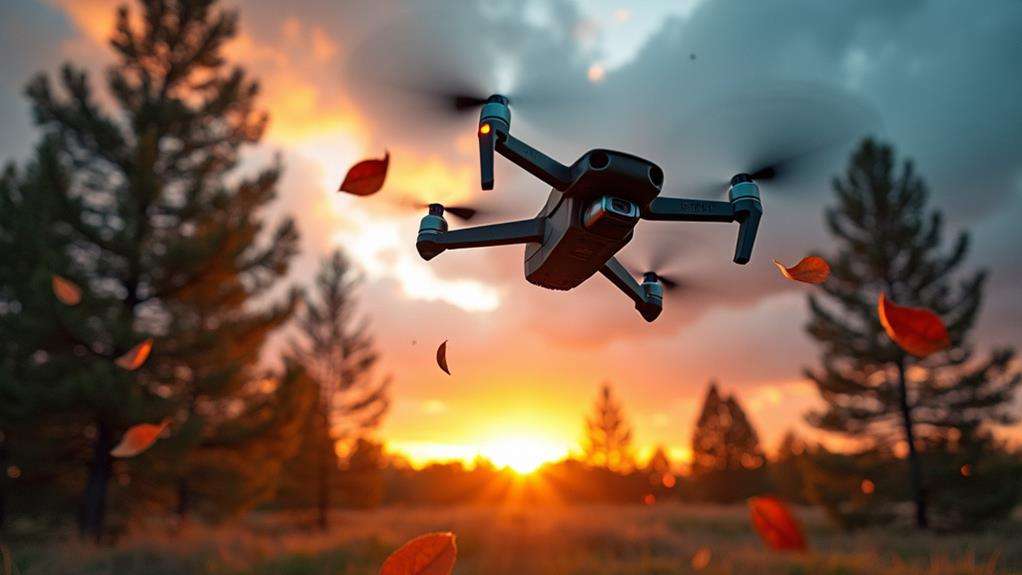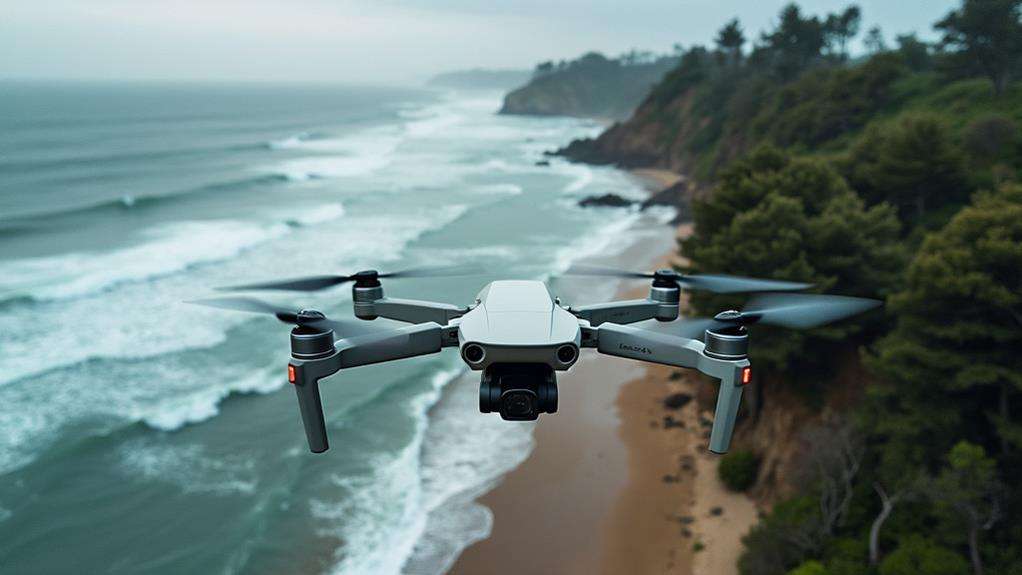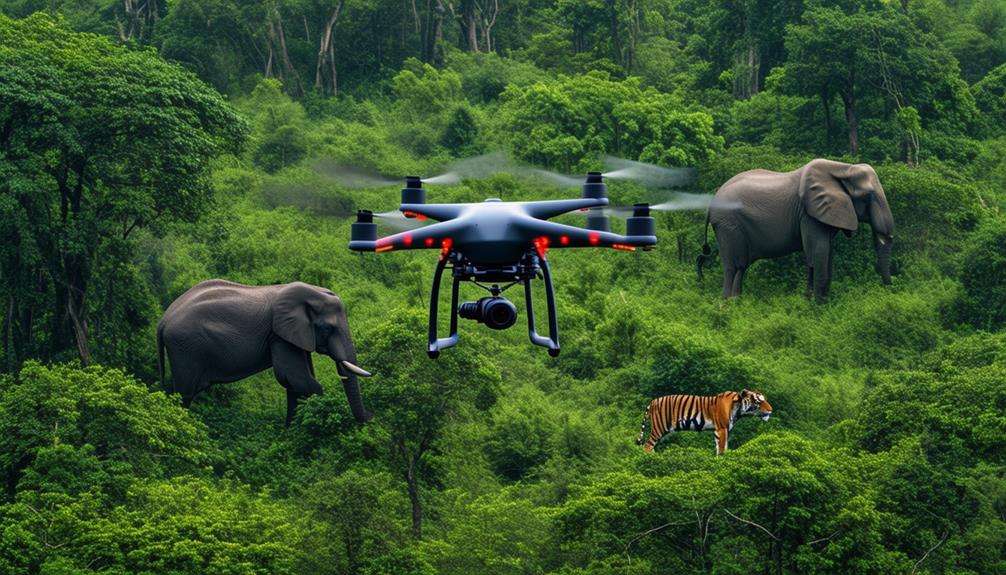Can Drones Fly in the Wind?

You might wonder if drones can handle windy conditions, especially if you're planning to fly one on a breezy day. While many consumer drones are designed to manage moderate winds, their performance can vary significantly based on wind speed and specific drone capabilities. Exceeding recommended limits not only affects control and stability but also impacts battery life and safety. How do you assess whether it's safe to fly, and what are the best practices for navigating windy weather? Let's explore these crucial considerations to enhance your drone-flying experience.
Wind Resistance Levels
Understanding wind resistance levels is crucial for flying drones in windy conditions. Each drone is rated for a specific wind resistance level, indicating the maximum wind speed it can handle without losing control. For instance, the DJI Mini 4 Pro can manage winds up to 10.7 m/s (approximately 23.9 mph), making it suitable for moderate wind conditions. Most consumer drones can handle wind speeds ranging from 10-15 m/s (22-34 mph). Beyond these speeds, flight stability is significantly compromised, making it challenging to maintain control.
Flying in strong winds requires more power, impacting your drone's battery life. The drone must work harder to maintain stability, leading to faster battery depletion. Therefore, if you plan to fly in windy conditions, it's essential to monitor battery levels closely and be prepared for shorter flight durations.
Experienced pilots understand the importance of knowing a drone's specific wind resistance capabilities. Different models handle wind differently, so always check your drone's specifications before taking off in strong winds. This knowledge ensures safer flights and better performance, even in less-than-ideal weather conditions.
Beaufort Scale Insights
Understanding the Beaufort scale is essential when preparing to fly your drone. This scale categorizes wind speeds, helping you determine safe and risky conditions. For most consumer drones, optimal flying is achieved at wind levels 0-1, while anything above level 7 typically necessitates professional-grade equipment.
Understanding Wind Categories
Navigating the skies with your drone requires more than just technical skill; it demands a keen understanding of wind categories, particularly through the lens of the Beaufort Scale. This scale categorizes wind speeds from 0 (Calm) to 12 (Hurricane), providing a framework for assessing the maximum wind resistance your drone can handle.
Levels 0-1 on the Beaufort Scale represent ideal flying conditions, with calm winds that allow any drone to operate smoothly. However, as wind speeds increase, so do the challenges. Levels 8-12, ranging from 39 to 73 mph, are particularly risky. Wind speeds in these categories typically exceed the operational limits of most consumer drones, making stability and control nearly impossible.
Using an anemometer, you can measure real-time wind speeds to determine if it's safe to fly. By understanding and applying the Beaufort Scale, you'll make more informed decisions, ensuring your drone's safety and enhancing its performance. Knowing your drone's limits is crucial when flying in windy conditions.
Safe Wind Speeds
Understanding wind categories is crucial for recognizing safe wind speeds for drone flight. The Beaufort scale can help determine suitable flying conditions. Levels 0-1 (Calm) offer ideal conditions for optimal drone performance. As you move up the scale, caution is necessary. Levels 8-12 (Moderate Breeze) mark the upper limit for many consumer drones, requiring vigilance.
When wind speeds exceed 25 mph (Strong Breeze), most consumer drones struggle to maintain control, making it unsafe for regular operations. At this point, professional-grade equipment designed for high winds is required. Flying in strong winds, particularly at levels 39-54 mph (Gale to Severe Gale), is extremely risky and generally prohibited due to a high likelihood of crashes.
Most consumer drones have a wind speed resistance of 10-15 m/s (22-34 mph). Always avoid flying in conditions exceeding 2/3 of this limit, roughly around 15 mph. To ensure safety, check the weather forecast and use an anemometer for real-time wind speed readings. This helps navigate gusts effectively and keeps your drone safe.
Assess Wind Conditions

Assessing wind conditions is crucial for safe and efficient drone flight. Before taking off, check the wind speed. Most consumer drones are recommended to avoid flying in winds exceeding 10-15 mph. Understanding the Beaufort scale can help you determine if the wind conditions are within safe limits. Levels 0-1, indicating calm winds, are ideal for flying, while levels 8-12 generally represent the upper limit for many consumer drones.
Using apps like Windy.com or UAV Forecast can provide real-time data on wind speed and direction, aiding in pre-flight assessments. Remember, wind speed can significantly affect your drone's battery life. Flying against headwinds will drain the battery faster, reducing flight time.
During the flight, continuously monitor wind conditions. Gusts can suddenly exceed sustained wind speeds, potentially destabilizing your drone. Always be vigilant and prepared to bring your drone back if the wind picks up unexpectedly. By closely monitoring wind conditions, you can ensure a safer and more controlled flight experience.
Takeoff and Landing Tips
Mastering takeoff and landing techniques is essential for safe and stable drone flights. Always take off and land directly into the wind to enhance stability and minimize lateral movement during these critical phases. Continuously monitor wind conditions, especially in windy environments. If you notice excessive drone movement, be prepared to abort the flight to maintain control.
For landing, maintain a low approach angle, ideally around 20% pitch, to counteract sudden wind gusts and ensure a smooth descent. Choose a stable landing pad that absorbs wind impact and prevents sliding; heavier pads offer a more secure foundation, particularly in high wind situations.
Avoid taking off and landing in winds exceeding 10-15 mph, especially if you are a beginner. This precaution helps maintain control and ensures safety. Safety should always be your top priority when operating drones in windy conditions. By following these tips, you can improve your takeoff and landing success rates, leading to safer drone flights.
Battery and Payload Impact

Flying drones in windy conditions can significantly affect battery life and payload performance. High winds force your drone to work harder to maintain stability, resulting in increased battery consumption. Consequently, flight time can be drastically reduced, particularly when flying against headwinds. As a drone pilot, you must understand how wind impacts both battery life and payload capacity.
- Increased Battery Consumption: Windy conditions demand more power for stabilization, causing quicker battery drain.
- Reduced Flight Time: Headwinds can significantly cut flight time, necessitating a conservative approach to distance and duration.
- Payload Weight: Heavier payloads amplify the effects of wind on battery life, making stabilization and altitude maintenance more energy-intensive.
- Thrust-to-Weight Ratio: Drones with lower thrust-to-weight ratios struggle more with stability and battery efficiency in windy conditions.
- Battery Monitoring: Always closely monitor battery levels when flying in wind to avoid unexpected depletion.
Understanding these factors will help you better manage your drone's performance in challenging conditions.
Stabilization Techniques
Navigating wind's unpredictable nature requires effective stabilization techniques to ensure smooth and controlled drone flights. Using gimbal stabilization is essential as it reduces camera vibrations caused by wind, ensuring your footage remains clear and smooth. When your drone is affected by gusts, tilting it slightly into the wind helps maintain better control and stability, countering lateral drift.
Activating GPS hold mode can be transformative. This feature keeps your drone in a fixed position despite wind forces, allowing for hands-free operation without losing control. When landing, a lower approach angle (around 20% pitch) enhances stability and mitigates the risk of sudden wind gusts causing crashes.
Engaging sports mode can also enhance your drone's capabilities in windy conditions. It improves maneuverability, enabling quicker adjustments to changing wind patterns, helping you fly more confidently.
| Technique | Benefit | Emotion |
|---|---|---|
| Gimbal Stabilization | Smoother video footage | Satisfaction |
| Tilt into Wind | Better control and stability | Confidence |
| GPS Hold Mode | Maintains position | Peace of mind |
| Low Approach Angle | Safer landings | Relief |
These techniques ensure semantic accuracy, completeness, consistency, conciseness, relevance, interoperability, and trustworthiness in drone stabilization.
Pre-Flight Preparation

Before taking off, verify the weather forecast using reliable apps like Windy.com or UAV Forecast to ensure wind conditions are safe. Conduct a thorough inspection of your drone to check for any damage and confirm all components are functioning correctly. Plan your flight path meticulously, taking into account wind direction and potential obstacles, to guarantee a smooth and controlled flight.
Weather Forecast Apps
Preparing for a successful drone flight requires meticulous weather condition checks, and apps like Windy.com and UAV Forecast are invaluable tools for this purpose. These apps provide real-time data on wind conditions, crucial for drone pilots. Windy.com offers detailed information on wind speed, direction, and gusts through visual maps, aiding in assessing safe flying conditions. UAV Forecast is tailored specifically for drone users, offering hourly updates on wind conditions to enhance flight planning accuracy.
Checking local weather before each flight is essential, as real-time changes can impact drone stability. Familiarize yourself with your drone's wind resistance specifications, often available in these apps, to determine safe flying limits.
To enhance your pre-flight preparation, consider these key features:
- Visual wind maps: Understand wind patterns and potential gusts.
- Hourly forecasts: Access up-to-date wind conditions for better planning.
- Airspace regulations: Ensure legal compliance by highlighting restricted areas.
- Custom alerts: Receive warnings of sudden weather changes.
- Wind resistance data: Assess whether your drone can handle current wind conditions.
Using these weather forecast apps can significantly improve your flying experience and help maintain drone stability.
Drone Inspection Checklist
After confirming weather conditions with reliable forecast apps, proceed to ensure your drone is flight-ready. Begin your inspection by checking for any visible damage, as even minor issues can impact performance, especially in windy conditions. Verify that your drone's battery is fully charged to maximize flight time and maintain control during potential wind challenges.
Ensure that the propellers are securely attached and undamaged, as wind resistance can exacerbate any weaknesses. Additionally, check for firmware and software updates; keeping these current ensures optimal functionality and performance, particularly in varying wind conditions.
Refer to the following checklist to ensure a comprehensive inspection:
| Inspection Task | Description |
|---|---|
| Inspect for damage | Check for visible issues affecting performance |
| Ensure battery is fully charged | Maximize flight time and control |
| Verify propellers | Secure and undamaged for wind resistance |
| Check firmware and software | Ensure updates are current |
Flight Path Planning
Considering the importance of wind conditions, thorough flight path planning is essential for a safe and successful drone operation. Always check weather forecasts to assess wind conditions before flying. Use reliable weather monitoring apps like Windy.com and UAV Forecast to obtain real-time data on wind speed, direction, and any strong gusts. This information aids in planning your flight path effectively.
Experienced drone pilots understand the criticality of knowing their drone's wind resistance. For instance, the DJI Mini 4 Pro can handle winds up to 23.9 mph. Familiarize yourself with these specifications to ensure your flight plan aligns with your drone's capabilities. When planning your flight, aim to take off and land into the wind to enhance stability and control during these critical phases.
To keep your flight safe, consider these steps:
- Check weather forecasts using reliable apps.
- Familiarize yourself with your drone's wind resistance.
- Plan your flight to take off and land into the wind.
- Identify safe landing zones as part of your contingency plan.
- Understand local airspace regulations regarding windy conditions.
Recommended Weather Apps
When planning a drone flight, reliable weather apps are essential for ensuring safety and success. Among the top recommendations, Windy.com excels with its detailed visual maps of wind speed, direction, and gusts, allowing you to assess wind impact on your drone's battery life and stability.
UAV Forecast is another excellent choice, offering real-time weather data, including hourly wind conditions, temperature, and precipitation. This ensures you can make informed decisions about the safety of flying in specific conditions.
For those needing a combination of airspace maps and weather data, AirMap is indispensable. It provides up-to-date wind speed and direction information, crucial for maintaining control and safety, especially for licensed drone pilots.
For hyper-local forecasts, Weather Underground is invaluable, providing precise weather updates for your specific flying area. This enhances safety by offering targeted wind condition tracking.
Lastly, Meteogram provides a graphical representation of weather trends, showing detailed wind speed changes over time. This helps you anticipate and plan for varying conditions, ensuring your drone can handle different scenarios.




